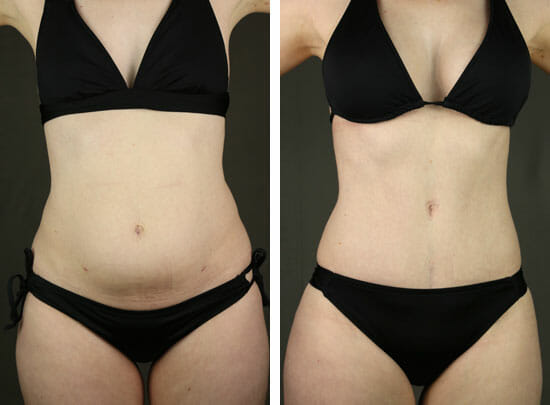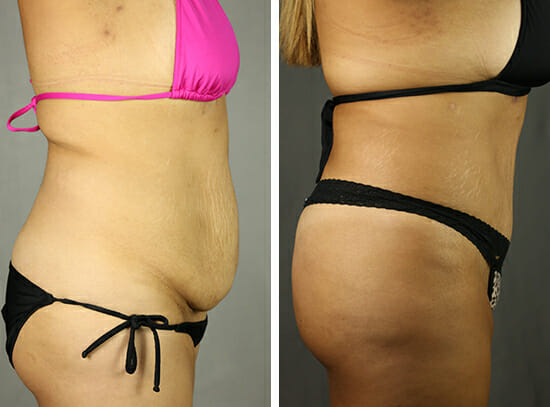Tummy tuck faq answered by Dr. David Newman, Board Certified Plastic Surgeon in Temecula, CA.
Am I a candidate for a tummy tuck?
This is the most important question a patient can ask a plastic surgeon because it not only addresses who can get the best result but more importantly, how can one make themselves the best candidate for a tummy tuck and who is the best candidate in terms of safety.
There is no other cosmetic surgery besides a tummy tuck where a patient can literally make themselves into a better candidate for surgery to get better results and at less risk. By both losing weight mostly before the procedure, the tummy can be made flatter because there is less fat inside the abdomen to tighten against. And, although patients are not that familiar with BMI (body mass index) unless they have had weight loss surgery, this number can be a rough guide for patients considering a tummy tuck who have not yet been evaluated by a plastic surgeon. The best plastic surgeons don’t recommend a tummy tuck for patients with a BMI over 30 but this depends on the patient’s body frame and there are exceptions. Only an examination by an experienced abdominoplasty surgeon can help a patient to see if they care a candidate at their current weight. Plastic surgeons want the best results for their patients and again, the best plastic surgeons don’t just “operate on anybody” but rather support patients in their weight loss efforts and point the way with specific instruction to help patients get to their goals and make surgery the safest and most enjoyable experience possible.
Safety also relates to patient weight before surgery. For those with less body fat, the tissues have better blood supply and this translates into fewer healing complications. Plastic surgeons want patients to have successful surgery and go on to heal quickly so they can get back to their daily activities as soon as possible. Patients often report they ” look fat to themselves” in the mirror but this might be because pregnancy has caused the abdominal wall to stretch out. So it’s hard for some patients to tell if they are overweight or if their tummy just looks big from childbirth. At consultation, a plastic surgeon can immediately assess a differentiate these two issues and make recommendations regarding weight loss or rather proceeding with surgery.
Some patients have already done the work of weight loss after childbirth and are therefore good candidates for a tummy tuck (abdominoplasty). Patients who are at a good weight already generally have a BMI in the 22 to 27 range, depending upon their body type. One issue that may frustrate patients is that they weigh more than they did when they were in high school and find it difficult or impossible to get that far down in weight. It is very important for patients to understand that their body is different after having children and that they should be less “hard on themselves” and reassess what their true weight should be, and especially take into account their body frame.
And very often, in consultation, a plastic surgeon can find some way to help a patient get to their weight goal that they themselves have not yet uncovered, a new way to help in their efforts to get to that special goal.
There are certainly other issues that make patients good candidates for a tummy tuck including overall good health. Plastic surgeons are thoroughly trained to uncover any medical issues that may affect surgery and a thorough examination and review of a patient’s history helps ensure that a patient is a safe candidate for a procedure.
One of the most obvious but least discussed issues that make a patient a good candidate for any surgery is whether that surgery can fix the problem and to what degree! The rule of thumb is that the worse the problem is, and in this case the worse the tummy appears, the bigger the change that can result from the surgery and the more worth it is to do the procedure. This may seem obvious to patients or may “go without saying” but is one of the most important deciding factors in cosmetic surgery.
What happens during a tummy tuck?
There are two basic parts to a tummy tuck, also known as abdominoplasty. The skin removal part is more commonly known to patients and involves removing all excess skin or tightening up the skin of the front of the abdomen. Skin is removed in different amounts depending on how loose the skin is and the location of the loose skin. Most patients after childbirth have what is known as a standard tummy tuck (standard abdominoplasty) and in this surgery the skin and underlying fat of the lower half of the tummy are removed and the upper abdominal skin stretched to cover the lower part. This is possible (for those who are in severe doubt about this) because there is usually folding and stretchy skin within the upper abdomen. For patients with minimal skin laxity, a mini tummy tuck is a good option and a good plastic surgeon will certainly point that out at your consultation.
The second goal of a tummy tuck is the flattening of the front of the abdomen and this is done after the skin, mentioned above is lifted to expose the abdominal wall. The abdominal wall is really the container for the abdomen and is stretched with pregnancy. The abdominal wall is really composed of multiple layers of thin sheets of tissue called fascia (fa-sha) which look like a sheet of linen. Underneath and in between these layers of fascia reside the abdominal muscles. All of the fascial layers and the muscle are fused together to form the abdominal wall. For the purposes of discussion about tummy tucks, it’s also good to think about the layers as one “wall” because during a tummy tuck, sutures are used on the outside to tighten the outermost layer with the goal in mind to flatten out the abdomen.
When a patient has laxity of the abdominal wall from their upper abdomen to their pubic area, a standard abdominoplasty or tummy tuck is usually the best option although there are several other options for patients. When patients have laxity or a prominence of only their lower abdomen, a mini tummy tuck can be a great option to not only get the best results but also with less operative time, at less cost and with a quicker return to activities of daily living and sports.
Does a tummy tuck fix a hernia? If I have a hernia can it be fixed with a tummy tuck?
Whether a patient has a hernia can usually be determined at initial physical examination with a plastic surgeon. Patients who have a hernia can often feel it themselves or notice it in the mirror or even have discomfort. There are several types of hernias and even situations that can appear as a hernia but are really not! Lets discuss these different possibilities.
Our abdominal wall is made up of sheets of linen called fascia which are arranged with the muscles of the abdomen to form a wall. This wall is under the skin of the front of the abdomen and keep our organs inside our abdomen . When a hole forms in the abdominal wall, the contents of our abdomen can push through the hole to reside under the skin and can be felt as a lump. The tissue that “herniates” through the hole in the abdominal wall is most commonly just fat but can rarely be abdominal contents and this is one reason why some doctors may recommend that patients have their hernia repaired. Hernias of the abdominal wall are more common in patients seeking tummy tucks because childbirth not only can stretch out the front of the abdominal wall but can also cause hernias. The most common hernia in these patients is an umbilical hernia (belly button hernia). Umbilical hernias are generally not dangerous but when patients are considering a tummy tuck, it may be easiest to have the umbilical hernia repaired with the tummy tuck. This is because the hernia can be easily seen at the time of a tummy tuck, can be easily repaired and the repair reinforced with natural tissues. These natural tissues are the outer layer of fascial that is normally folded over together when the tummy tuck is done to make the abdomen flatter. The repair of an umbilical hernia during the course of a tummy tuck is generally curative and saves the patient a trip to the general surgeon for an additional surgery.
Another issue that may occur with tummy tuck patients is a “diastasis recti”, literally separation of the sit up muscles. Some women may notice that when they attempt to do a sit-up, a bulge occurs in the midline of their abdomen that runs from top to the bottom of their abdomen. These patients often say that when this happens, it looks like their “guts are coming out”. This manifestation occurs because the sit-up muscles have been stretched toward the side of the tummy which leaves a space in the middle and makes patients think they might have a hernia. But this is not a hernia and rather just a separation of the muscles and when the skin is raised a thin layer of fascia can be seen between the inner edges of the muscles and so there is no true “hole like opening of the abdominal wall but rather a thinning of its layers. Patients with a diastasis recti are treated in the same fashion as other tummy tuck patient with complete tightening of the center of the abdomen with sutures to achieve as flat an abdomen as possible.
Are tummy tucks painful?
Tummy tucks are half as painful as they used to be because of a new man-made local anesthetic called Exparel. This medication has revolutionized the care of tummy tuck patients and has radically both lessened discomfort and the duration of discomfort after surgery.
Exparel is a new man made anesthetic that is injected during surgery into all of the areas of the tummy tuck. It works immediately to reduce discomfort and so works right away in the recovery room to limit pain. Patients are discharged to home and because of the Exparel, are able to walk for ten minutes every two hours right away after their procedure and are much less “hunched over” like they used to be. The next day patients are generally walking inside their home for a significantly longer than the first day and after they are seen on the second day after their procedure they are placed into a gently compressive garment and instructed to walk outside. Patients are generally walking outside, one mile, twice a day at four to five days. It is very important for patient who have had tummy tucks to get back to their usual routine as soon as possible to avoid getting blood clots (DVT) that can occur rarely after tummy tuck. Now, with Exparel, patients are quickly returning to their activities.
What is a mommy makeover?
It’s important to understand that there is no specific surgery called a mommy makeover but there are changes in a woman’s body that occur with childbirth and breast feeding that may require cosmetic surgery for improvement. And since each woman is affected by childbirth differently, a specific plan can be devised together with a plastic surgeon to get back towards a patient’s pre-baby appearance.
Mommy makeover surgery generally involves a tummy tuck and some kind of breast surgery which includes a breast augmentation with or without a breast lift. Patients who “need” a tummy tuck almost always require suction of the hips and so a mommy makeover sometimes involves liposuction of the hips and thighs/knees. One of the most important aspects of mommy makeover surgery is the duration of the combined surgeries. It is common knowledge to plastic surgeons that surgeries that last more than five hours carry greater risk for complications. Therefore, it is important to take this under consideration when crafting a mommy makeover. The five hour rule exists for all patients, no matter how healthy or young they are at the time of surgery. Having two surgeons operate for three hours is still 6 hours (six man x hours) of treatment and is therefore considered six hours of surgery. A thorough consultation with a Plastic Surgeon can help patients plan for their best alternatives, best results and the safest surgery.
If you have any further questions about the tummy tuck procedure that were not answered in this tummy tuck faq, please call our office to schedule a free consultation with Dr. Newman.



